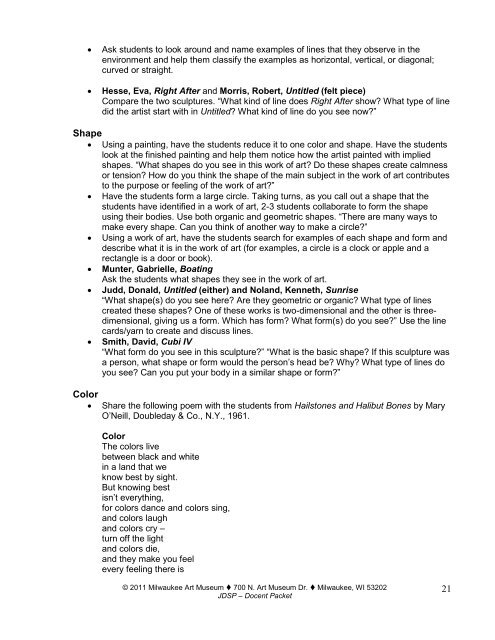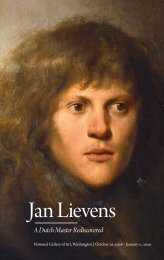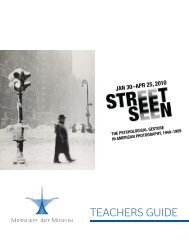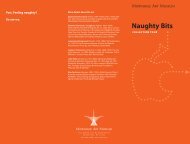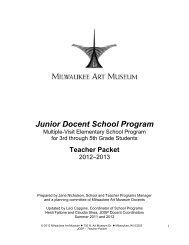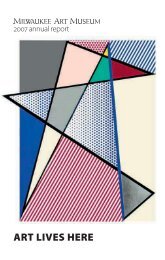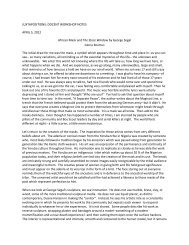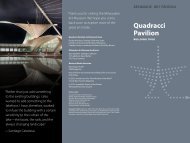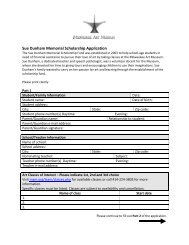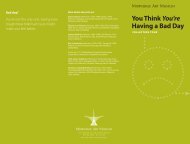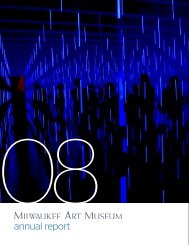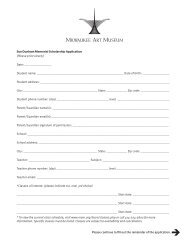Junior Docent School Program - Milwaukee Art Museum
Junior Docent School Program - Milwaukee Art Museum
Junior Docent School Program - Milwaukee Art Museum
Create successful ePaper yourself
Turn your PDF publications into a flip-book with our unique Google optimized e-Paper software.
Ask students to look around and name examples of lines that they observe in the<br />
environment and help them classify the examples as horizontal, vertical, or diagonal;<br />
curved or straight.<br />
Hesse, Eva, Right After and Morris, Robert, Untitled (felt piece)<br />
Compare the two sculptures. “What kind of line does Right After show? What type of line<br />
did the artist start with in Untitled? What kind of line do you see now?”<br />
Shape<br />
Using a painting, have the students reduce it to one color and shape. Have the students<br />
look at the finished painting and help them notice how the artist painted with implied<br />
shapes. “What shapes do you see in this work of art? Do these shapes create calmness<br />
or tension? How do you think the shape of the main subject in the work of art contributes<br />
to the purpose or feeling of the work of art?”<br />
Have the students form a large circle. Taking turns, as you call out a shape that the<br />
students have identified in a work of art, 2-3 students collaborate to form the shape<br />
using their bodies. Use both organic and geometric shapes. “There are many ways to<br />
make every shape. Can you think of another way to make a circle?”<br />
Using a work of art, have the students search for examples of each shape and form and<br />
describe what it is in the work of art (for examples, a circle is a clock or apple and a<br />
rectangle is a door or book).<br />
Munter, Gabrielle, Boating<br />
Ask the students what shapes they see in the work of art.<br />
Judd, Donald, Untitled (either) and Noland, Kenneth, Sunrise<br />
“What shape(s) do you see here? Are they geometric or organic? What type of lines<br />
created these shapes? One of these works is two-dimensional and the other is threedimensional,<br />
giving us a form. Which has form? What form(s) do you see?” Use the line<br />
cards/yarn to create and discuss lines.<br />
Smith, David, Cubi IV<br />
“What form do you see in this sculpture?” “What is the basic shape? If this sculpture was<br />
a person, what shape or form would the person‟s head be? Why? What type of lines do<br />
you see? Can you put your body in a similar shape or form?”<br />
Color<br />
<br />
Share the following poem with the students from Hailstones and Halibut Bones by Mary<br />
O‟Neill, Doubleday & Co., N.Y., 1961.<br />
Color<br />
The colors live<br />
between black and white<br />
in a land that we<br />
know best by sight.<br />
But knowing best<br />
isn‟t everything,<br />
for colors dance and colors sing,<br />
and colors laugh<br />
and colors cry –<br />
turn off the light<br />
and colors die,<br />
and they make you feel<br />
every feeling there is<br />
© 2011 <strong>Milwaukee</strong> <strong>Art</strong> <strong>Museum</strong> 700 N. <strong>Art</strong> <strong>Museum</strong> Dr. <strong>Milwaukee</strong>, WI 53202<br />
JDSP – <strong>Docent</strong> Packet<br />
21


